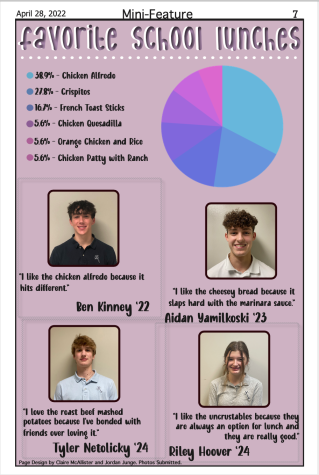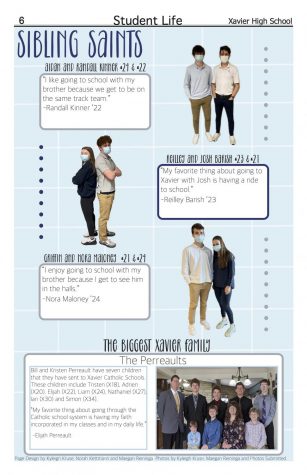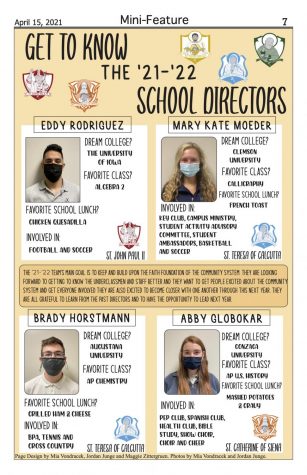Saints participate in Iowa Caucuses
February 23, 2016
Since 1972, the delegate selection process for each presidential campaign cycle has kicked off with the Iowa caucuses. The purpose of the caucuses is to show Iowa’s preference for certain candidates by winnowing the larger pool of presidential hopefuls in each party down to a manageable number of viable candidates. After the Iowa caucus, remaining candidates move on to a primary election in New Hampshire, which is followed by primaries and caucuses in the remaining states across the country. This year’s Democratic candidates were Hillary Clinton, Martin O’Malley, and Bernie Sanders. Republican candidates included Jeb Bush, Ben Carson, Chris Christie, Ted Cruz, Carly Fiorina, John Kasich, Marco Rubio, and Donald Trump.
Caucus participants needed to be Iowa citizens who will be 18 by election day. Participants are able to register party affiliation (Republican, Democrat, or Independent) at the caucus site. Each precinct has a Democratic and Republican caucus. Caucus sites – typically a school, government building, or church – are assigned to voter precincts. Voter precincts are established based on physical residence. Independents can attend either a Democratic or a Republican caucus, but a registered Democrat cannot attend a Republican caucus and vice versa.
The Democratic and Republican caucuses have different procedures that yield the same results. At the Republican caucus, participants sit together with fellow residents of their precinct and listen as representatives speak on behalf of each candidate. After speeches, each precinct nominates and elects a Caucus Chair and Caucus Secretary. The Caucus Chair represents the precinct at the county convention while the Caucus Secretary is responsible for tallying votes in the Presidential Preference Poll, which is the next major order of business at the caucus. The Caucus Chair reads the names of candidates for whom participants may vote in the Presidential Preference Poll. At this point, caucus participants write their choice on their ballot. A hat is passed to collect ballots. While the ballots are counted and documented by the Caucus Secretary, the Caucus Chair leads participants in discussion, voting, and approval of positions in the party platform.
During the Democratic caucus, participants meet at their precinct caucus location and physically show support by grouping together by candidate. Like the Republican caucus, a precinct chairperson is nominated and that individual conducts an initial count of participants in each group. Groups must be contain at least 15 percent of the participants to be included. Delegates are allotted to each candidate based on the ratio of their supporters. If the initial count identified a group of participants as not viable (containing fewer than 15 percent of total participants)the participants of that group must join one of the other viable groups to have their vote counted.
As 17 and 18 year olds, many Xavier students had the opportunity to participate in their first caucus.
“I thought it was really fun to be involved in the political system,” senior caucus-goer Katie Neumeyer said. “It was interesting to see candidates like Ted Cruz come and speak at my caucus.”
Sixty eligible junior and seniors were asked if they planned on participating in the 2016 presidential caucus. Of those 60, 40 said they planned on participating: 11 as Democrats and 29 as Republicans. Going into caucus, nine of the 40 students said they would support Rubio, seven were for Sanders, four for Cruz, three for Paul, two for Trump, two for Clinton, one for Carson and 12 were undecided. One Xavier senior, Andy Globokar spoke on behalf of Rubio at his precinct’s caucus.
“It was pretty cool,” Globokar said. “There were 1300 people there. There were six different precincts all in one church. Ted Cruz was actually there and he spoke for himself. It was a little intimidating speaking on the same stage as Ted Cruz, but it was also a once in a lifetime experience.”
The winner for the Republicans in the Iowa caucuses was Cruz, receiving 27.6 percent of the vote. Cruz was followed closely by Trump and Rubio who secured 24.3 percent and 23.1 percent, respectively. For the Democrats, the race was much closer. Clinton ended up winning the majority, receiving 49.9 percent of the vote. Sanders was a close second with 49.6 percent. After earning only 0.6 percent of the vote, O’Malley suspended his campaign.













